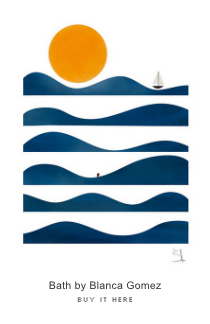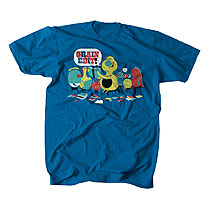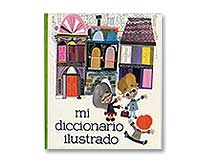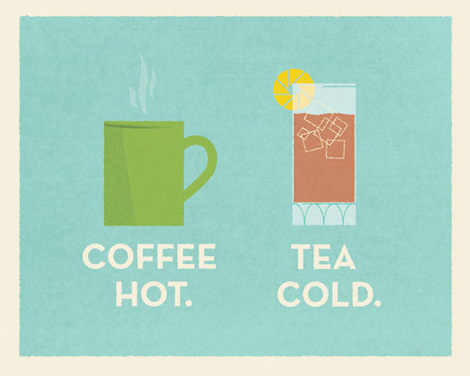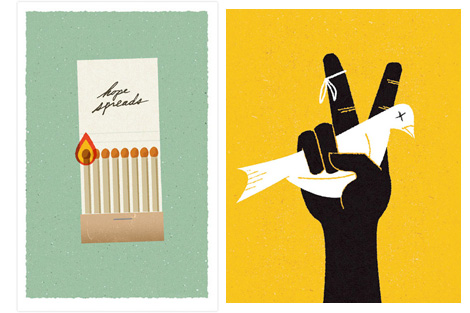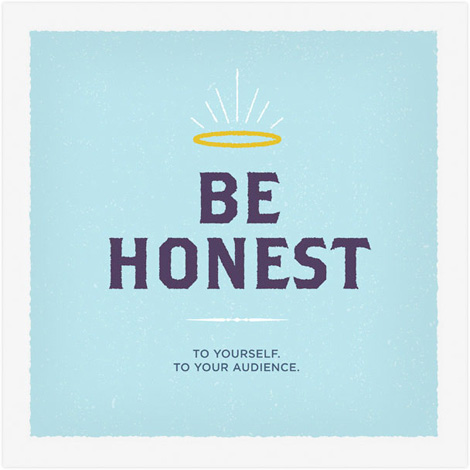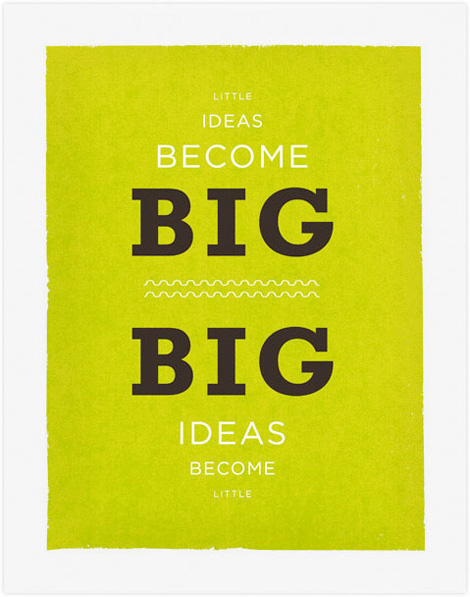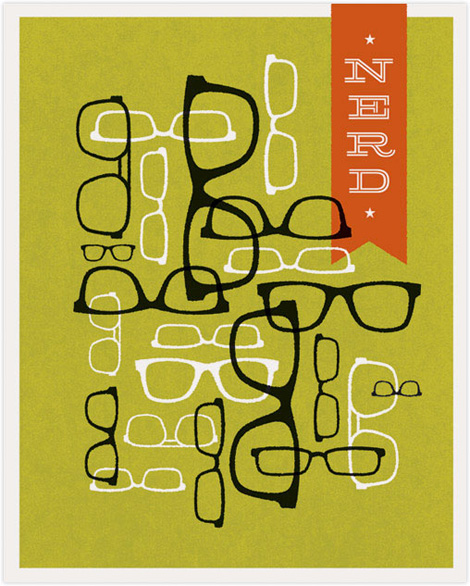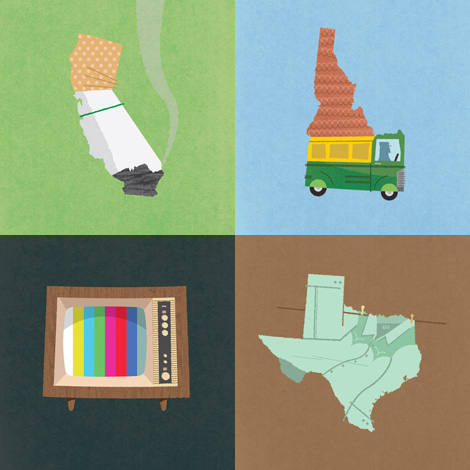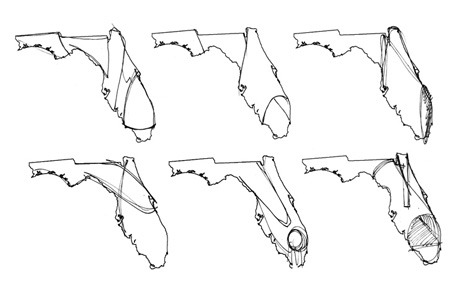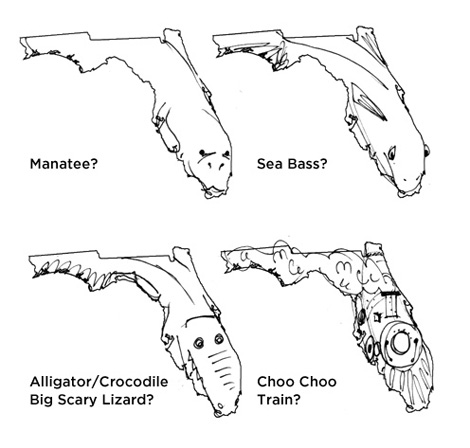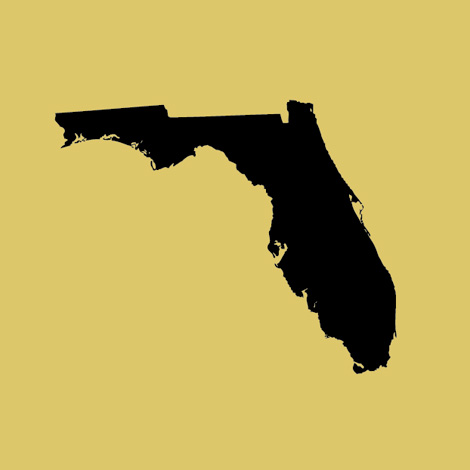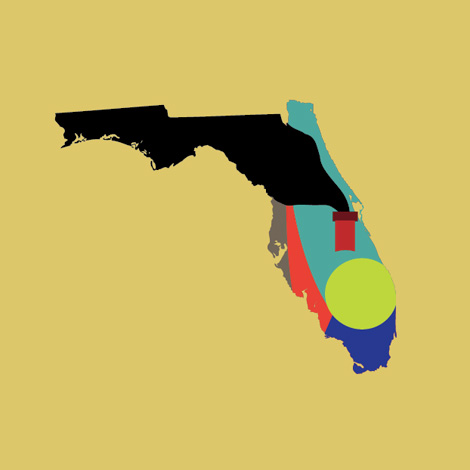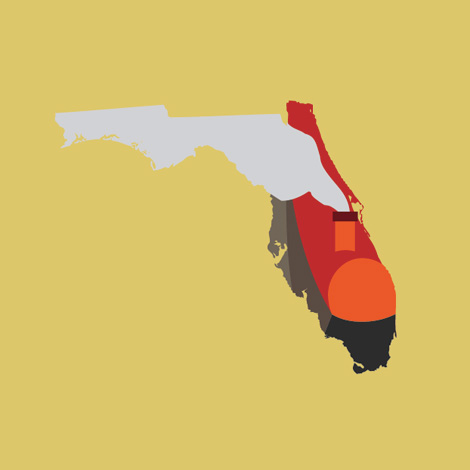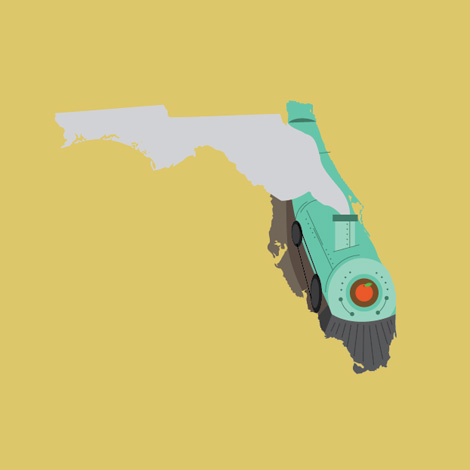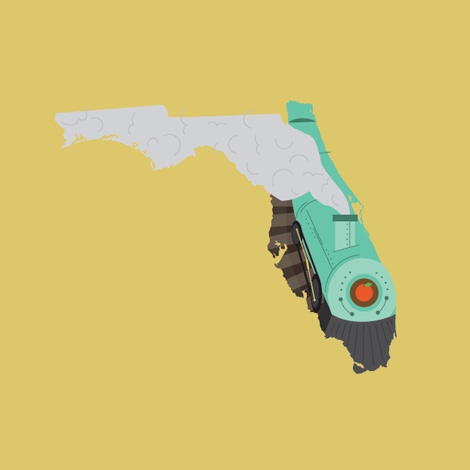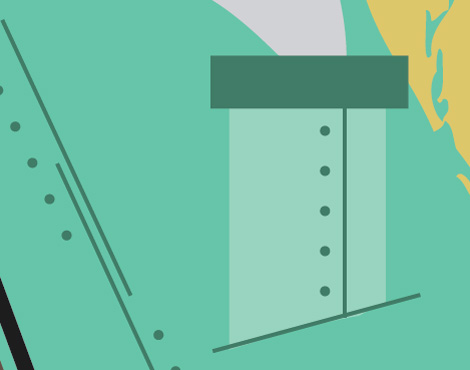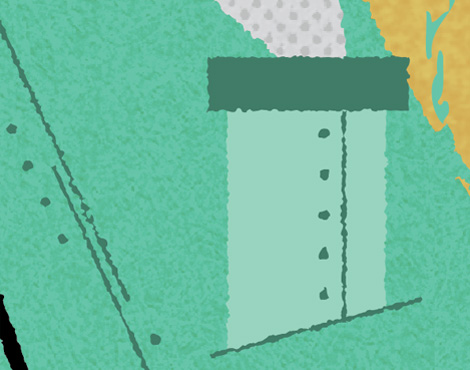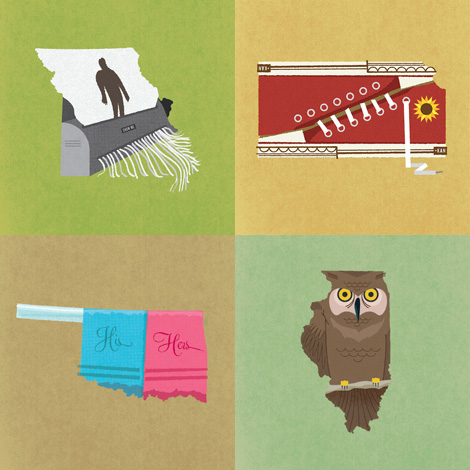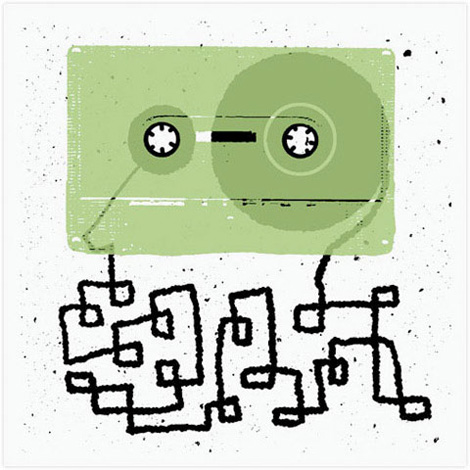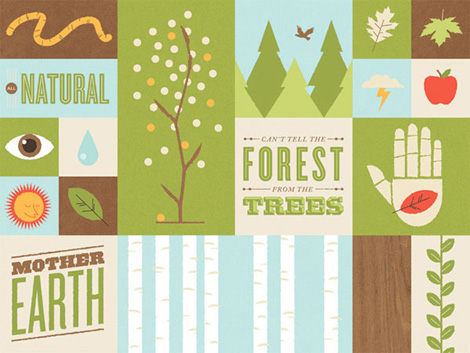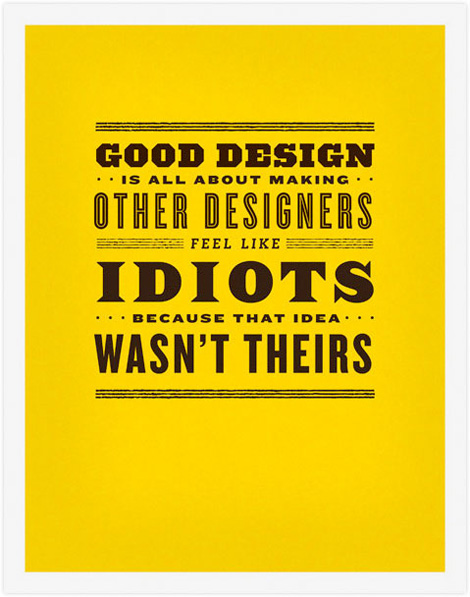Frank Chimero interview
I’m very excited about our next addition to the Grain Edit interview series. When the gigantic Grain Edit interview arrow landed on Springfield, MO we knew just who to call: Frank Chimero.
You’ve likely seen Frank’s designs and illustrations making the rounds on the design blog circuit lately. And with good reason; Frank’s work effortlessly combines humor, wit, and style with a fresh and honest point of view.
Frank opens up and shares some of his thoughts and insights regarding his design background, his influences and teaching experiences, and of course his famed process. If you’re a fan of the States’ series, then there’s also a super surprise waiting for you further down in the interview.
OK, enough. Here we go:
1. Where are you from originally?
I was born on Long Island in New York about 20 miles outside of the city. My parents are from Brooklyn, so I like to think I still have a little bit of the city in me. When I was 8, we moved to Missouri and I did half of my growing up there.2
2. When and how did you come to be interested in graphic design?
I’ll skip all the stuff everyone says about how they’ve always drawn and wanted a creative career where they could support themselves. I think I got in to this just like a lot of other designers my age: in high school, I had friends in bands and they needed stuff. Posters, album designs, t-shirts, stickers. After talking to folks, it’s interesting how many designers get their interest and start in design out of a love for music. Anyway, that need and love transitioned into making designs, since I don’t really have any musical talent of my own. I didn’t really know what I was doing, but that was the fun of it.
3. Did you attend a traditional design school? Where, or why not?
I thought design was something I needed to get serious about because I enjoyed it so much. I went to school for it at Missouri State University, where I now teach. I studied illustration and design. I was fortunate enough to have a bit of experience and focus from the get-go, so a lot of my efforts in school weren’t about how to do things (although there was a healthy dose of that), but mostly why to do certain things. Thankfully, the school is fantastic and was well equipped to teach me those things. The funny thing about the school is that it’s nestled in the corner of Missouri, but you walk in to class and you’re being taught by award-winning designers and illustrators from eastern European countries like Bosnia, Russia, and Poland.
4. What was your first design job?
I’m still on it. When I graduated from school, people were telling me I had tons of options of where I could go and what I could do. It scared me to death. Lots of options are typically presented as a good thing, but I find it paralyzing. I didn’t want to make a decision about where to move or where to work. It might have been the wrong one.
So, I decided to stick around in Missouri for a summer and freelance. It’d buy some time for me to make up my mind. Freelancing grew, the clients got further away and work starting paying more than the bills. I just decided to ride out the wave.
I’m still on that same wave, it seems. Each year I survive on my own I consider to be a small miracle.
5. You run a solo studio. What do you enjoy about being on your own, as opposed to the design firm environment? Do you feel you’re missing anything from not being in a studio environment?
I’ve never really worked in the “design firm environment” officially, so this is total speculation on my part. I think my favorite thing is the flexibility. Flexibility in the work, flexibility in time. I generally get to dictate how things move and in what direction. And more than that, since I’m only responsible for putting food in my own mouth, I have a lot of liberty to turn down a lot of jobs. Everyone has their bread and butter work, but because it’s only me, I can be more selective with what I choose to do.
I think that I feel like I’m only doing the work that’s worth doing. That’s what makes me so happy at the end of the day. But I still have issues turning down projects. My goal for this year is to say no more frequently and yes more strategically. I have a tendency to overbook myself.
One of the biggest things I miss out on by working alone is design community and feedback. One of the best decisions I’ve made is to move in to a shared office space with a couple of friends who run their own creative businesses (photography and videography). It’s valuable to know that even though I’m by myself in this “business venture,” I’m not by myself in this creative journey. I love getting their feedback, and I’m lucky enough to have a tight network of design and illustrator friends online that I tap for kinship and insight.
But still, it’s nice having real people in the room. It’s not the same playing hookie on a week day by yourself.
6. What are your biggest design influences? What contemporary designers do you admire?
I think I can easily say that my biggest influence is Alan Fletcher. When I first started studying graphic design, one of my professors slipped a copy of “The Art of Looking Sideways” under my nose. And I think it changed my life. I’m not sure I can really explain it to the full extent that I felt it, but I connected with that book and it’s content. Here was a book about design that wasn’t about design at all. It was more than that. It was about visually experiencing things, a life style. People had been selling me the idea that design was a lifestyle, and it just seemed snooty and stuffy to me. Just a bunch of people that took themselves too seriously in turtlenecks with lattes rambling on about the virtues of semantics.
But Fletcher was different. His work is about curiosity and happiness, wit and innocence. It’s amazing. Through his work, I got a slight glimpse of what I wanted to do with this design thingie, even though I don’t think I fully understood it at the time. I wanted to be curious and let as many things and experiences in me as I could. Then, let them become a vital part of me and share the results of that with everyone else. I knew that’d make me happy, and on a hunch, I hoped (and still hope) it makes other people happy.
No one looked more alive on the page than Fletcher, and I think I’m shooting for that myself. I’m no where close yet, but I still have to try. There are other influences (Rand, Bass, Lustig, Flora, etc.), but they’re stylistic influences. Fletcher for me is aesthetics and content.
For contemporaries, there’s a whole slew of them, many of which I’m fortunate enough to consider friends. A quick role-call would include Don Clark at Invisible Creature (who I consider my illustrative comrade), Kate Bingaman-Burt, Ben Barry, Jez Burrows, Meg Hunt, Olimpia Zagnoli, and the boys at BBDK.
7. You work on a lot of personal projects. What percentage of your work is personal vs. commercial? Do you prefer one over the other?
From an output point, I’d say maybe 50/50? Time-wise, I’d say it’s 80/20, more commercial. There’s different qualities to both that I enjoy. With the commercial work, it’s always nice to feel like you’ve done something really well despite the limitations of the project. Plus, it’s always nice to do something and have the client be enthusiastic about it. But I think personal work will always have a special place. It’s the lab where I try out new ideas, and every scientist loves their lab.
8. Tell us what the typical Frank Chimero work day looks like.
Wake up. Levitate to shower. Apply sunscreen. Weave friendship bracelets. Continue work on my popsicle stick suspension bridge. Air guitar solo. Check email and respond accordingly. Watch RoboCop 2. Draw something or two. Check email again. Cash checks. Go to bed.
Actually, all of my work days look like this: teach in the mornings (I start at 8am), each lunch while responding to emails, then spend the afternoon on “real work.” I’ve been trying to disconnect a little bit more lately to give myself large blocks of uninterrupted time, and that’s proven valuable, so I may go dark for a few hours during the day to get things done.
9. Describe your design process. Is your approach to designing definable or systematic? Does it change depending on the project?
It’s pretty defined. The specifics change, but the general process for illustrations is: Research > Brainstorming > Freak Out > Sketch > Approval > Render Final. Here. Let me show you:
1. So, the first thing is to just choose a state. I’m working with Florida. I always like to take the outline and just put them 6 or 8 up on a page for sketching. I print out 5 or 6 sheets. No big deal if the sketch isn’t good, I can just move on to the next outline. If I run out of paper, I can print more. It’s a nice workflow. Mistakes don’t burn as much.
I typically don’t come in to the process with a predetermined idea. I like to “unearth” the idea during the process. The longer I work on this project, the more I realize that this project isn’t about form or style, like I initially thought. It’s about recognizing potential and running with it. I love that.
Sometimes the process of coming up with the idea is quick. (Florida happened in about 30 minutes of sketching.) Sometimes it’s not. (Texas took 3 weeks.) My first step is just “feeling” the shape. I draw lines to make implied paths. What sorts of shapes compose this main shape? How does the shape flow? What wants to be inside of it?
2. Now the hard part. What’s it look like? I typically try multiple ideas. To get my mind going, I look at the shape upside down. Through the paper so it’s flipped. At an angle. Whatever I can do to have me look at this as a shape, and not as Florida. I look kind of dumb while I do this. I’ve learned that I should do it when I’m by myself.
Here, I’m trying out a few ideas. Something long and curling? An alligator? A fish? A manatee? Nah. That manatee doesn’t look like one. It’s too skinny. Not cowish enough. Doesn’t work well with the shape. The alligator is nice, but too predictable? His legs don’t integrate in very nicely into the shape. A train? Oh. Wow. That’s nice. Maybe we can use the smoke to trail off to the left to fill that difficult space. Ok. Bingo!
3. So, the idea is intact in sketch form. Lots of clarity, but not so much I can’t fudge things a bit while working on it. So, I start with the basic silhouette of the state.
4. Next, I block in the basic shapes inside of the general silhouette. Nothing fancy to look at here. Just your general “underdrawing.” I’m using radical colors so I can focus on the shapes themselves.
5. Once I’m pretty happy with the shapes, I start to figure out a palette. Various shades of different colors, etc. Just to get a feeling for what the overall character of the illustration will be.
6. Ok, so I decided to completely change the color scheme here. I wanted a nice warm/cool contrast, and besides, you can’t put an orange on the train if the whole train is orange. I’m starting to add the little details in as well. The lines, the dots, the seams, etc. This is my favorite part of the process. These are the “spice” to what I’m cooking: they’re the little pieces that take the idea and make it seem special.
7. More refinement. The illustration is nearing completion. The base of the illustration itself is finished, so it’s time for even further polish work. I enjoy flat shapes, but I think on their lonesome, they look dull on the page. So, I focus on two things. Edge and texture.
8. Here we have the vector drawing with only the flat shapes. Looks computerish, right? I don’t like that. The idea didn’t come from a computer. We need to get some hands in to this. So, I’m going to pull a bit of texture into the illustration, and then muck up the edges so they aren’t so precise.
9. This is what that same area looks like after I’m done texturing and messing with the edges. The textures come from scans of different surfaces, photocopies and paper I’ve collected. The edges get distorted by tracing over them with a real marker and paper. (I use a fine-tipped Sharpie on cheap copy paper, so it bleeds a little bit.) I then take the lines that I’ve drawn, scan them, and live trace them in Illustrator. The end result is what you see here.
10. And finito! This is what the final piece looks like once all of the polish work is finished:
10. In addition to design, you also teach at Missouri State University. How do you feel teaching has impacted your own work?
Oh man, teaching has really benefitted me so much. First thing, it really makes me consider the reasons why I do certain things. A lot of the decisions I make while working on my own things is just a gut reaction. “Not this, but rather this.” It’s helpful for me to have to really lay out solid reasons why to do certain things. Also, it forces me to be a little less dogmatic. I have certain things that I just don’t like, and other ideas that I consider to be unequivocally true, but teaching classes reminds me that not everyone is going to have the same communication goals as myself. The truth is round, not solid.
Also, my students do so much to inspire. They work. Hard. Work ethic is contagious for me, so it’s great to be around 40 hard-working individuals every week. Also, it’s such a thrill to see them get excited and figure things out. It reminds me of when that was happening for me while I was in school, and gets me excited to think that those “Aha” moments don’t stop after you finish school.
11. How do you know when a project is “finished”?
The way that my process works, it’s 80% about the idea and 20% about the rendering (at least from my perspective on this side of the drawing table). So I generally know if the idea is “finished” by judging the sketch. The roughness of the sketch allows me to isolate the idea from it’s treatment. Does the idea have that spirit I want? Will it feel alive on the page and provide a bit of a visual wink? If so, it’s the idea is finished. The rendering of the idea is finished once I feel like it has enough polish to feel well rendered, but not so much that it detracts from the elegance, simplicity, or any of the other qualities the idea may have.
12. How do you pair a concept with your distinct style?
I have no idea! The two don’t seem terribly separate to me. I do think it’s important for me to know the limitations of this style though. I have to keep things purposefully simple, because I don’t think I’d be able to draw some sort of really complex narrative scene. No, this style is open and needs to be presented simply. “This is what the idea is. Here, I hope you like it.”
The style is stripped back and it does one thing, so it becomes crucial to figure out what that one thing needs to be. Also, if I’m combining two things that used to be separate in to a new hybrid to bring in new meaning, it helps to refer to common ground and the things with which we’re familiar. That way, everyone can plainly understand to what I’m referring.
The best common ground I’ve been able to find thus far are everyday objects. There’s this great quote from Robert Rauschenberg where he says he feels sorry for people who think the every day objects in our lives our ugly, because those objects surround us. The whole situation must make them miserable. I find objects like Coke bottles, pencils and coffee cups really appealing because people understand them. They have intimate experiences with them, and hopefully it makes my work more intimate as well. It’s like my work and all of us exist in the same world. No need to construct new ones: this one is plenty beautiful and good.
13. You seem to be a master of the “visual wink,” as you put it. It’s that place where delight and inform meet, and the aspect that makes design work memorable and unique. Plus it’s easy to be too heavy-handed and overshoot. Can you talk about how you get to that place?
Master? I’m not sure I would say that. But I think that the delight someone gets from looking at the work is a reflection of the delight the creator had while making it. Those winks come from me trying to be light-hearted about my work and what I’m trying to say. If I want the work to be playful, I have to play while I’m making it. It is very easy to be heavy-handed with this sort of stuff, but I think the judgment call comes from intuition and experience. It’s like knowing the best way to tell a joke, and then deciding if you can even tell it based on the company that you’re keeping that moment. You can’t really dictate those sorts of rules to paper, you just have to listen to your gut.
14. What’s new and cool for Frank? Any current projects you can talk about?
Oh man. There’s so much happening right now. I’ve been really fortunate the past few months to have some amazing opportunities extended to me. I’ve been keeping busy with client work and editorial illustration, and I have spent the past few weeks working on an animated music video. Other than that, I have a whole set of states I need to put the finishing touches on and get released. This summer, I think I’ll be starting on some book projects as well: I have a couple ideas I’d like to pitch to publishers.
15. I really like best-of lists. What were your top ten favorite things from last year?
I think I can safely say it’s been the best year of my life thus far. All of these things are outstanding, and from 2008.
1. Finishing my first state, California. It was the first time I totally felt like I “owned” my work, and it taught me how to be visually genuine.
2. Ending my first semester of teaching by looking at all of the work. I was proud of myself, but even more proud of my students. They did something great, and I had piles of work to prove it.
3. Working on the Jailbirds video for Good Magazine. I don’t know why, but the project really resonated with me. Not necessarily because of the content, but rather realizing the potential of adding narrative to my work.
4. Trying to cross a road full of scooters on foot in Danang, Vietnam. I was like the frog in Frogger. There’s a special feeling of levity in exploring cultures and places that are completely new and different.
5. Chess in the Park in Geneva, Switzerland with my pal Doug Wilson. I still remember what I had for lunch that day, and can still feel the soaking mist of the Jet d’Eau.
6. Seeing Sigur Ros alone. No one could go with me, so I went anyway by myself. And it didn’t matter that I was alone: I closed my eyes and the whole world disappeared.
7. Moving close to work. I live across the street from my studio. This is most excellent for mid-afternoon snacks and naps.
8. Driving from Missouri to Chicago, May 4, 2008. I think this was the last time I felt like I was floating above all of the things I usually concern myself with. Just for a little bit, they didn’t matter.
9. Writing (Again). Duane King asked me to commit some of my thoughts to writing for his Thinking for a Living blog. The whole ordeal has reintroduced me to a new creative practice which I love in strangely different, yet oddly familiar way.
10. Uncovering the things that truly make me happy. Narrative. Levity. Space. Warmth. Food. Drink. Connection. People.
Frank did a cool video for GOOD Magazine’s Transparency series, entitled “Jailbirds.” Check it out over at GOOD.
I would like to give a big “Thank you!” to Frank for sharing his time and thoughts with us in this interview. You can see the rest of his work, and keep up-to-date with his happenings on his website.
Be sure to check out Frank’s shop as well, where many of the pieces shown here are available for sale.
——————————-
Enjoy reading this interview? Please leave a note in the comments and consider signing up for our tasty free grain edit RSS feed.
Tagscontemporary, Designers, graphic-design, Illustration, interview, posters, Typography, USA
03.12.09 in Designers, Features by Ethan
Share on Facebook


















